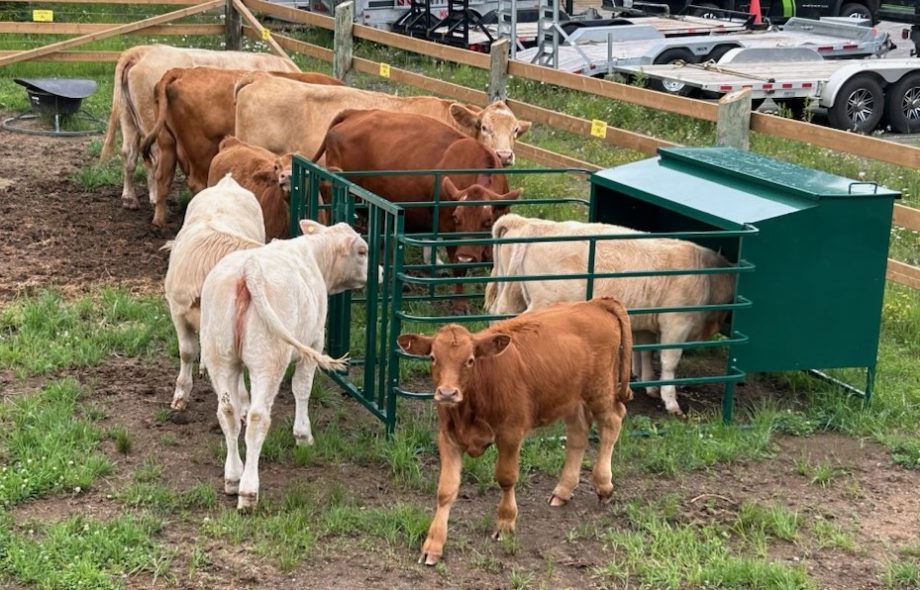Raising healthy calves is the cornerstone of a productive cattle operation. One essential tool that many livestock producers rely on to ensure proper nutrition and growth for their young stock is the calf creep feeder. But what exactly are calf creep feeders? What are their benefits, what types are available, and how can you choose the best one for your farm?
In this comprehensive guide, we’ll explore the advantage creep feeders bring to your herd management, review different feeder types, and offer practical tips for selecting from the wide range of creep feeders for sale—including insights on how they compare to swine creep feeders and the role of mineral feeders for sale in your overall feeding strategy.
What Exactly Are Calf Creep Feeders?
Calf creep feeders are specially designed feeding stations that allow young calves to access supplemental feed, such as grain or pellets, while restricting access to larger cattle. The “creep” design involves size-appropriate entry points, which adult cows cannot pass through, preventing competition and ensuring calves receive the nutrition they need during the critical early growth stages.
This method of controlled feeding is a proven strategy for improving calf health, weight gain, and weaning success.
Why Are Calf Creep Feeders So Advantageous?
What Are the Key Benefits?
Targeted Nutrition for Calves
Calves have higher nutritional requirements relative to their size compared to adult cattle. Advantage creep feeders provide them with constant access to high-energy feed without interference.
Reduced Feed Waste
By preventing larger animals from accessing calf feed, creep feeders reduce waste and improve feed efficiency, which translates to cost savings over time.
Less Stress and Competition
With a dedicated feeder, calves don’t have to compete with adult cows for feed, reducing stress and promoting more even growth across the herd.
Improved Weaning Weights
Calves consuming creep feed often wean at higher weights, leading to better health and increased profitability for producers.
What Types of Calf Creep Feeders Are Available?
When shopping for creep feeders for sale, you’ll find several options tailored to different herd sizes, budgets, and management styles. Here are the main types:
1. Open Trough Creep Feeders
• Simple design with a low trough accessible only to calves.
• Easy to fill and clean.
• Best for dry, sheltered environments.
2. Covered or Enclosed Creep Feeders
• Feature a roof or cover to protect feed from rain and moisture.
• Help reduce spoilage and mold growth.
• Ideal for outdoor or pasture use.
3. Portable Creep Feeders
• Lightweight and often equipped with wheels for easy relocation.
• Provide flexibility to move feeders as pastures rotate.
• Suitable for smaller herds or farms with varied grazing areas.
4. Automatic or Self-Feeding Creep Feeders
• Equipped with mechanisms to dispense feed as calves consume it.
• Reduce labor and maintain a consistent feed supply.
• Typically more expensive but ideal for large operations.
Should You Combine Calf Creep Feeders with Mineral Feeders?
Absolutely! Alongside supplemental feed, minerals play a crucial role in calf development—supporting bone growth, immune health, and overall performance. Integrating mineral feeders for sale in your feeding strategy ensures calves receive necessary vitamins and minerals.
Some producers place mineral feeders near calf creep feeders to encourage simultaneous consumption, which simplifies management and supports balanced nutrition.
How to Choose the Best Calf Creep Feeder for Your Operation
When evaluating creep feeders for sale, consider these key factors:
1. Durability and Build Quality
Look for heavy-duty materials like galvanized steel or high-impact plastic that withstand calf pressure and environmental exposure.
2. Size and Capacity
Select a feeder sized appropriately for your herd. Too small leads to crowding; too large may waste feed or space.
3. Ease of Cleaning and Maintenance
Feeders with smooth surfaces and removable parts simplify cleaning, helping prevent disease.
4. Weather Protection
If feeders will be outdoors, consider those with covers or roofs to protect feed from rain and sun.
5. Portability
If you move pastures frequently, portable feeders with wheels can save time and labor.
6. Cost vs. Long-Term Value
Investing in a quality feeder may cost more upfront but saves money by reducing waste and improving calf health.
Tips for Maximizing Your Calf Creep Feeder Use
• Introduce Feed Early: Start creep feeding calves as early as one to two weeks of age.
• Monitor Feed Intake: Watch for any calves not using the feeder and adjust placement or size.
• Keep Feed Fresh: Refill and clean feeders regularly to prevent spoilage.
• Position Strategically: Place feeders in shaded, dry areas to encourage use.
• Combine with Good Pasture Management: Feeders complement good grazing practices but don’t replace quality forage.
Conclusion
Calf creep feeders offer undeniable advantages—from improved calf nutrition and growth to reduced feed waste and stress. Whether you’re browsing creep feeders for sale for your small farm or large-scale operation, understanding the types available and how to select the best feeder is key to success.
Remember, while swine creep feeders serve piglets well, calf creep feeders are specifically designed for the needs and behaviors of young cattle. Combining calf creep feeders with quality mineral feeders for sale provides a holistic approach to calf nutrition, helping your herd thrive from birth through weaning.
Investing in the right calf creep feeder is investing in the future of your herd. With proper use and maintenance, these feeders pay off through healthier calves, stronger growth rates, and ultimately, a more profitable operation.
If you’re ready to explore your options, keep these insights in mind and choose the feeder that fits your herd’s size, environment, and management style best. lamb creep feeders


 :
: